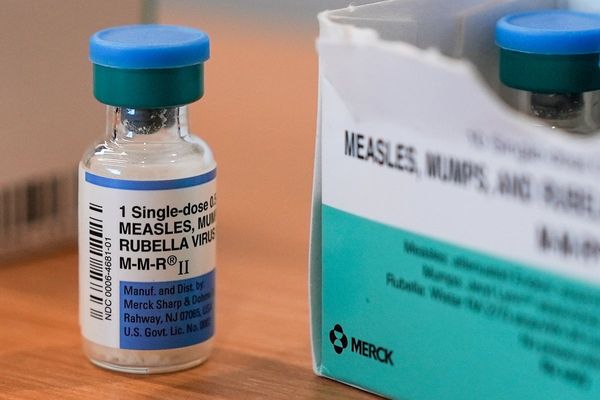
I joined Michelle Rook on AgWeb's Markets Now to break down the latest trends in the wheat, soybean, corn markets, interest rates, and the stock market. Watch the full interview here.
Michelle Rook: Welcome to Markets Now. I'm Michelle Rook with Darin Newsom, Senior Market Analyst with Barchart. Seeing a lot of red on the board in grain and livestock futures trade this morning. Darin, I want to start off talking about soybeans. We had a big three-day rally, 60, 65 cents of gains. Are we just seeing some profit-taking, you think here? Did we run up into some chart resistance?
Darin Newsom: Number one, I don't know the technicals really have anything to do with markets these days. My blink reaction to this is, maybe the reality of real fundamentals are sinking back in. We've seen soybeans spiked by, I'll be nice and just say a social media post on Monday or early Monday morning. Then that was followed up by this past Wednesday's USDA imaginary numbers with some very interesting figures for the soybean that really test the limits of someone's imagination. It is what it is. The design was-- the intention for both of those events was to trigger algorithm buying, and that's what happened.
Now here we are on Thursday morning, the buy orders have been filled, market was pushed higher, didn't really change anything on the charts, didn't really change anything. It certainly didn't change anything fundamentally. Thursday morning, a little bit of a vacuum underneath these things starting to sink lower again as we head towards the next weekend. The focus will be back on whether crop still looks good. What future spreads have been telling us all along, that the US is going to produce more soybeans than what it has demand for. That's the bottom line.
Michelle: Yes, especially if we don't get China back in the market and it looks like we've kicked the can down the road again here, huh?
Darin: Again, this gets so much attention, but China's not going to be back in the market. There were two stories out Monday from the same media company. The first one that came out around midnight just basically reiterated what we've known since 2018, that Chinese buyers have done the math to basically deal the US out of the global soybean game. That hasn't changed. The only thing is, the situation continues to go down that same path. China has a long-term view of anything that is called war. They take a long-term approach. The US has an attention span of 15 minutes.
Four hours later, the story came out of same media group, of what the US president posted to social media. Now, I understand that in the last decade, social media has become official policy. It doesn't have to go through Congress, doesn't have to go through the channels that we used to think were in place, the checks and balances, and so on. It's what is posted to social media. The reality is, again, and we can see in the futures, we can see-- excuse me, we can see in the spreads, we can see in the market in general, supply and demand situation hasn't changed.
China's not going to buy unless there is some sort of weather problem in Brazil. Then maybe that increases the attractiveness of US markets. Until then, I just don't see it changing.
Michelle: We also had cancellations of old crop soybean exports. We had cancellations of old crop corn exports. Corn right now, new crop looks pretty good. Overall, do you think that-- is demand even good enough to chew through as big a crop as we have on corn?
Darin: Let's look at what's happened in calculated full commercial carry. Both corn and soybean new crop spreads, new crop forward curves saw the percent of calculated full commercial carry increase during July and through the early part of August. That tells us right there that demand is not expected demand by the commercial side, not necessarily by the fund side. They just simply follow with the fundamentals. They will eventually follow the fundamentals. On the commercial side, those that actually matter, those who are, say, exporters or end users or large terminals or so on, the opinion is that expected supplies continue to gain on projected demand. That's what we see in both markets.
It doesn't matter if USDA comes out and says, US is going to produce 18 billion bushels or whatever it was of corn and 5 billion or 3 billion bushels of soybeans, whatever the numbers were. I don't even know. The bottom line is there's going to be more supplies in relation to demand. That hasn't changed. No, demand is not keeping up. The fact that we got some cancellations through the first part of August isn't overly surprising. We're into the last month of the marketing year for corn and soybeans. If it hasn't been shipped by now, it's probably not going to be, which makes USDA's move to, in its latest guesses, increase old crop export demand for both corn and soybeans that much more humorous.
Michelle: Weather, obviously, has been bearish for this market, and I can't remember an August where we've had better weather, at least to start off with.
Darin: Yes, this has been incredible across the Plains, across the Midwest. Love them or hate them, for what they're worth, US Drought Monitor comes out every week, every Thursday morning. This time around, again, similar to last week, you just don't see any hotspots really across all of the plains, from the northern border of North Dakota all the way down to the southwest border of Texas. There's a little bit in the far southwest edge of Texas, but you take it all the way across the Midwest over into Indiana, Ohio, and so on, and there just aren't any problem areas. Weather has been as close to ideal this time around, at a time when the US probably needed some weather problems.
Again, we can see in the market that, again, the commercial side just isn't overly concerned about what people still make up, still try to get people to trade these make-believe weather issues or growing issues that the crops just simply haven't had this year.
Michelle: The funds haven't had any weather threats to buy on either, but let's also talk a little bit about, we had CPI numbers out earlier last week. Actually, they looked fairly favorable, but PPI was out this morning, 0.9%, that was well above expectations. Does this take a rate cut in September off the table for the Fed?
Darin: I think it's an interesting discussion. I know there's dictates out there that says the Fed is going to have to cut rates, but the market isn't showing us that. As we watched the Fed fund futures forward curve, we saw that it was about a 50-50 chance that we would see a rate cut at the September meeting. This continues to get pushed back each month, almost as we approach the next meeting. Really, the meeting that's been in the spotlight for the last number of months has been the October get-together by the Federal Open Market Committee.
Do I think that the CPI and PPI numbers-- I know the economists watch this closely, but markets certainly didn't believe that we were going to see a cut, and I would still argue that there's a better chance for a rate hike before we get the next cut. Now, I'm going on a limb, I always talk about how I watch the market and let the market dictate my actions and these sorts of things, and the market certainly isn't indicating right now that we're going to see a rate hike, except for the fact that the US dollar technically turned bullish at the end of July. Again, can we believe what we see on charts anymore? I don't think so.
For now, I'm just going to stay on the sidelines and say we're not going to see a rate cut, at least from what I'm seeing in the markets at the September meeting.
Michelle: We're still not seeing the inflation show up in all of the data yet. There's a little bit of a lag effect from these tariffs. When does that show up here, Darin?
Darin: Again, these are government numbers and similar to the way USDA can change planted acres by two, three, four million, whatever it was, government inflation numbers don't necessarily have to be grounded in reality. Everyone that I hear from who goes to the store, and it doesn't matter if we're talking about a grocery store, retail store, implement dealer, tractor supply, whatever, prices are high. Inflation is real. We have seen increased inflation. The constant threat of tariffs and the ongoing trade wars have had an effect. They've continued to have an effect.
This is what sparked the initial flames of inflation between 2016 and 2018, and they've only gotten worse. Inflation is here. This is one of the reasons why I believe the Fed's still going to have to possibly raise rates before they cut rates, because that's the defense against inflation. That is to raise rates to hopefully strengthen the underlying currency, something that the US needs to see at this point.
Michelle: With what you just said and the fact that the stock market has continued to crack out new highs, does that keep the funds away from the grain market? Stock market still looks more attractive investment-wise, doesn't it?
Darin: It does for now. Yes. Markets that go to new highs have a hard time being considered bearish. We've seen new all-time highs posted in the S&P 500 and NASDAQ here through the midpoint of August. The Dow Jones, not yet. As you and I were talking about beforehand, the Dow Jones is our grandparents, I should say, stock index, more attention is now being paid to the S&P and NASDAQ as it should be. This comes down to the discussion of funds need a fundamental reason to get interested in the commodity sector. Again, this is where they can look for supply and demand. They could trade the weather. They can trade global crises and these sorts of things.
Outside of gold being a safe haven market and crude oil just fluctuating down near its lows in the low 60s, there's no fundamental reason for funds to get interested in the grains sector in general, particularly in the big three markets of corn, soybeans, and wheat. Until that changes, why go into grains when you've got the livestock sector sitting over there, a red-hot cattle market? Cash continues to go higher, continuing to tell us that supply and demand is way out of line in favor of demand over supply. If funds are going to move anywhere into commodities at this point, it's going to be into the livestock sector.
There's no fundamental reason for them to be interested in grains. Stock markets are doing well, livestock are hot. There are so many other markets that provide a better opportunity.
Michelle: No, not a good outlook for sure. All right. Thanks so much. Darin Newsom, Senior Market Analyst with Barchart. That is Markets Now.







